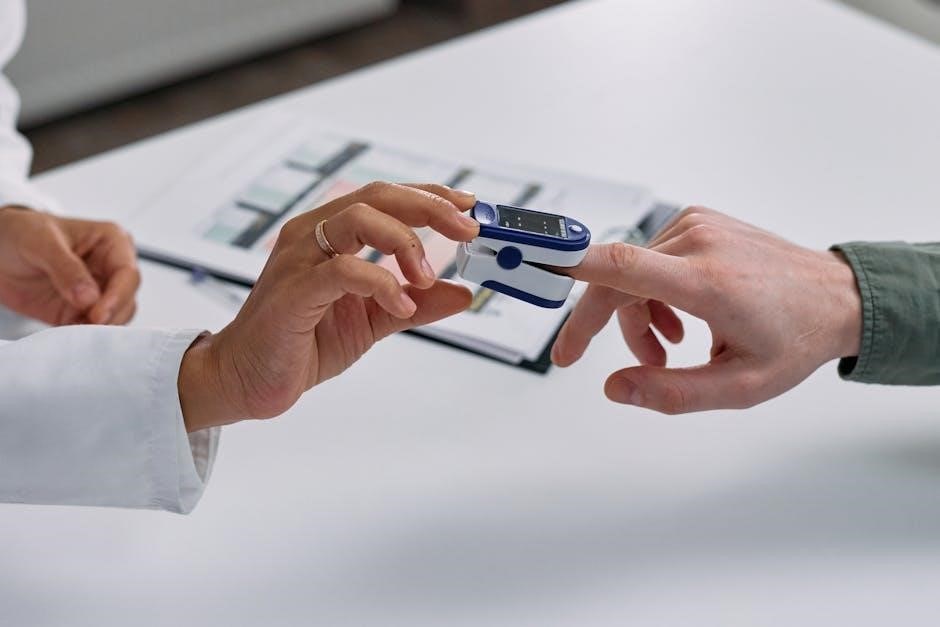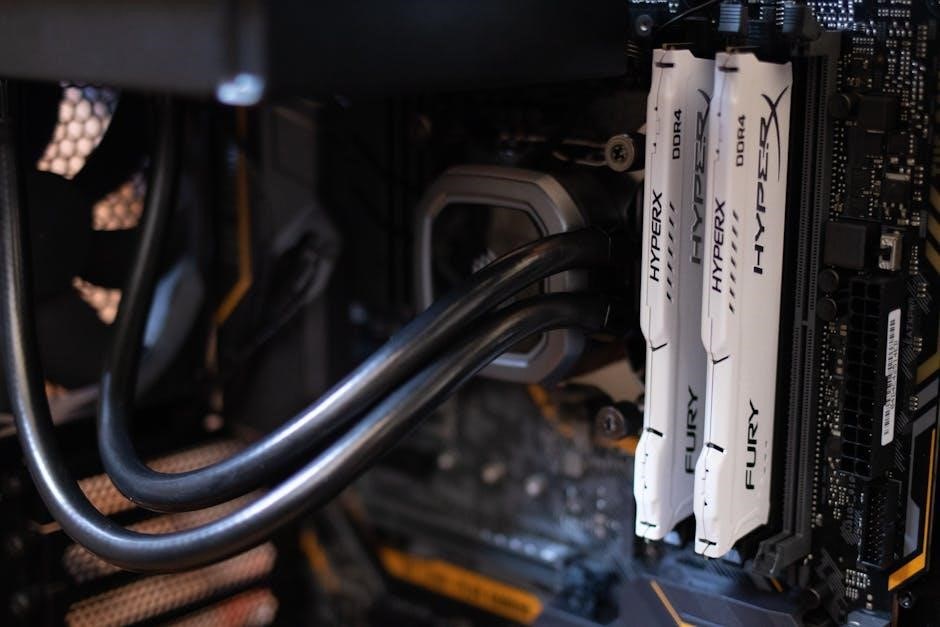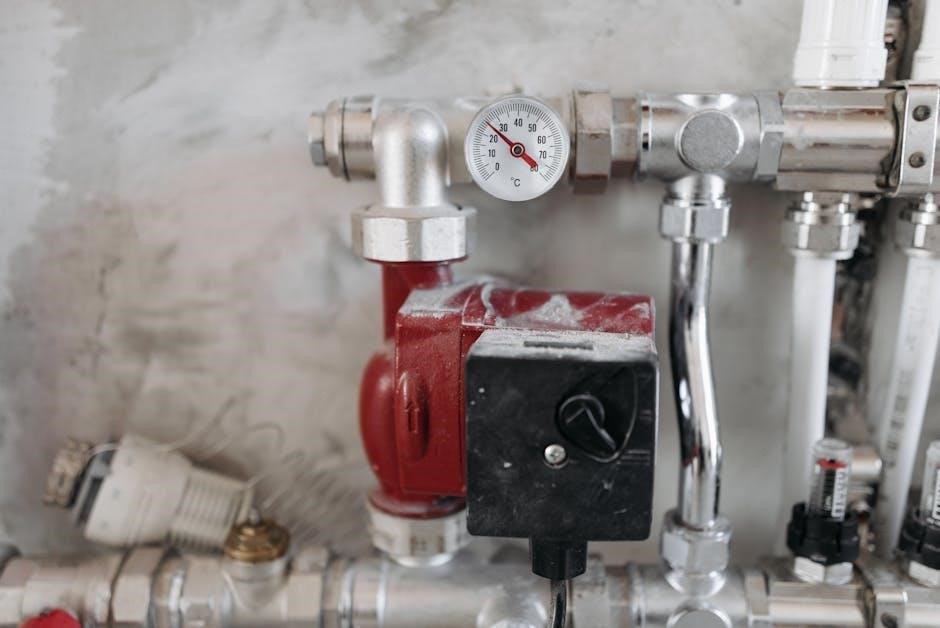This cardiovascular system worksheet introduces the structure and functions of the heart, blood vessels, and blood circulation. It explores key components, including chambers, valves, and circulation pathways in detail.
Overview of the Cardiovascular System
The cardiovascular system is a vital network responsible for transporting oxygen, nutrients, and hormones throughout the body while removing waste products. It consists of the heart, blood vessels, and blood. The heart acts as a pump, propelling blood through arteries, veins, and capillaries. Arteries carry oxygen-rich blood away from the heart to tissues, while veins return oxygen-depleted blood to the heart. Capillaries facilitate the exchange of substances between blood and cells. The system operates through two main circulations: pulmonary (between the heart and lungs) and systemic (delivering oxygen to the body). Blood, composed of plasma, red blood cells, white blood cells, and platelets, plays a crucial role in oxygen transport and immune defense. Proper functioning of the cardiovascular system is essential for maintaining health, regulating body temperature, and enabling physical activity. Understanding its structure and function is fundamental for diagnosing and managing cardiovascular diseases.
Importance of the Cardiovascular System in the Human Body
The cardiovascular system is essential for delivering oxygen and nutrients to cells and removing waste products, ensuring proper bodily functions. It plays a critical role in maintaining homeostasis, regulating body temperature, and supporting immune responses. Blood, its vital component, transports oxygen from the lungs to tissues and returns carbon dioxide for exhalation. The heart, as the central pump, ensures continuous blood circulation through arteries, veins, and capillaries. This system also enables physical activity by supplying muscles with oxygen and nutrients. Additionally, it aids in hormone distribution, connecting endocrine glands to target cells. Dysfunction in the cardiovascular system can lead to severe health issues, such as heart disease or stroke. Maintaining a healthy lifestyle is crucial to prevent these conditions and ensure optimal system performance. Understanding its importance fosters appreciation for the need to protect and care for this vital bodily system.
The heart is a muscular organ divided into four chambers: the left and right atria, and the left and right ventricles. It is enclosed in the pericardium, ensuring efficient blood circulation. The heart consists of four chambers: the right atrium, left atrium, right ventricle, and left ventricle. The atria are upper chambers that receive blood returning to the heart, while the ventricles are lower chambers responsible for pumping blood out of the heart. The right atrium receives deoxygenated blood from the body through the superior and inferior vena cava, which then flows into the right ventricle. The right ventricle pumps this blood to the lungs via the pulmonary artery. The left atrium receives oxygen-rich blood from the lungs through the pulmonary veins, which then moves to the left ventricle. The left ventricle, the strongest chamber, pumps this oxygenated blood to the rest of the body through the aorta. Each chamber plays a vital role in maintaining the circulatory process, ensuring efficient oxygen delivery and nutrient distribution. The heart contains four valves that ensure blood flows in one direction through the chambers. The tricuspid valve is located between the right atrium and ventricle, while the pulmonary valve is at the exit of the right ventricle, leading to the pulmonary artery. The mitral valve is between the left atrium and ventricle, and the aortic valve is at the exit of the left ventricle, leading to the aorta. These valves open and close with each heartbeat, preventing backflow and ensuring efficient blood circulation. Proper valve function is critical for maintaining healthy blood pressure and oxygen delivery. If valves malfunction, conditions like stenosis or regurgitation can occur, disrupting the cardiovascular system’s efficiency. Understanding these valves is essential for comprehending how the heart maintains proper blood flow and overall circulatory health. Blood vessels transport blood throughout the body, consisting of arteries, veins, and capillaries. Arteries carry oxygen-rich blood away from the heart, while veins return oxygen-depleted blood to it. Capillaries enable nutrient and oxygen exchange. The cardiovascular system includes three main types of blood vessels: arteries, veins, and capillaries. Arteries are thick-walled vessels that carry oxygen-rich blood away from the heart to the body. They have strong, elastic walls to withstand high blood pressure. Veins, on the other hand, return oxygen-depleted blood to the heart. They have one-way valves to prevent backflow and ensure blood moves in one direction. Capillaries are the smallest blood vessels, where oxygen, nutrients, and waste products are exchanged between blood and tissues. Their thin walls facilitate this exchange. Together, arteries, veins, and capillaries form a network essential for maintaining life, ensuring oxygen and nutrients reach all cells while removing waste. This vascular system is vital for overall health and proper bodily functions. Blood vessels are vital for transporting blood throughout the body. They consist of three layers: the innermost tunica intima, a smooth layer for blood flow; the tunica media, a muscular layer for contraction and relaxation; and the tunica externa, a protective outer layer. Arteries and arterioles regulate blood pressure and flow, while veins and venules return blood to the heart. Capillaries enable the exchange of oxygen, nutrients, and waste products with tissues. Blood vessels also play a role in maintaining blood pressure and circulation. Their structure allows them to adapt to physical demands, ensuring proper oxygen delivery and waste removal. Understanding their functions is crucial for grasping how the cardiovascular system maintains overall health and responds to disease. This knowledge is essential for identifying conditions like hypertension or atherosclerosis, which can impair vascular health. Blood is a vital fluid consisting of plasma, red blood cells, white blood cells, and platelets. It transports oxygen, nutrients, and waste while aiding immune responses and clotting. Its composition is essential for survival. Blood is primarily composed of four key components: plasma, red blood cells, white blood cells, and platelets. Plasma, the liquid portion, makes up about 55% of blood and serves as a medium for transporting cells, nutrients, hormones, and waste products; Red blood cells, or erythrocytes, are responsible for carrying oxygen throughout the body via the protein hemoglobin. White blood cells, or leukocytes, play a crucial role in the immune system by fighting infections and diseases. Platelets, or thrombocytes, are essential for blood clotting, preventing excessive bleeding when a blood vessel is injured. Together, these components ensure proper oxygen delivery, immune defense, and maintenance of vascular integrity, making blood vital for overall health. Understanding their roles is fundamental in studying the cardiovascular system. Blood plays a vital role in delivering oxygen and nutrients to cells while removing waste products. Red blood cells, containing hemoglobin, bind and transport oxygen from the lungs to tissues. Plasma, the liquid component, carries nutrients like glucose, amino acids, and fats, as well as hormones and enzymes essential for cellular function. Capillaries, the smallest blood vessels, facilitate the exchange of oxygen, nutrients, and waste products between blood and cells. This process ensures that cells receive the necessary resources for energy production and maintenance. Additionally, blood transports carbon dioxide and other waste materials from tissues back to organs like the lungs and kidneys for elimination. This continuous cycle highlights blood’s critical role in sustaining life and maintaining overall bodily functions. Understanding this process is essential for comprehending the cardiovascular system’s efficiency. The cardiovascular system comprises two circulation systems: the pulmonary circulation, transporting oxygen from the lungs to the heart, and systemic circulation, delivering oxygen to the body’s tissues and organs. Pulmonary circulation is a vital pathway within the cardiovascular system, responsible for transporting deoxygenated blood from the heart to the lungs and returning oxygenated blood. It begins when the right ventricle pumps blood through the pulmonary artery to the lungs. In the lungs, the blood flows through capillaries surrounding the alveoli, where gas exchange occurs: oxygen diffuses into the blood, and carbon dioxide is removed. The oxygen-rich blood then travels back to the heart via the pulmonary veins, which empty into the left atrium. This cycle ensures that the body receives oxygen while eliminating carbon dioxide. Pulmonary circulation is distinct from systemic circulation, as it operates at lower pressure and focuses solely on oxygenation. This process is essential for maintaining proper respiratory and cardiovascular function, ensuring the body’s tissues receive the oxygen they need to function efficiently. Systemic circulation is the process by which oxygenated blood is delivered to the body’s tissues and organs. It begins when the left ventricle pumps blood through the aorta, the largest artery, to smaller arteries and arterioles. These vessels distribute the blood to capillaries, where oxygen and nutrients diffuse into the tissues. Simultaneously, carbon dioxide and metabolic waste products are collected from the tissues and carried back through venules and veins to the right atrium. This cycle ensures that all cells receive the oxygen and nutrients necessary for proper function. Systemic circulation operates at higher pressure than pulmonary circulation, enabling it to supply the entire body. It is regulated by mechanisms that maintain blood flow and pressure, ensuring efficient delivery of oxygen to meet the body’s demands. This process is crucial for sustaining life and supporting the body’s metabolic activities. Engage with interactive exercises, labeling diagrams, and fill-in-the-blank tasks. Activities include matching blood vessels with their functions and completing assessments to enhance understanding of the cardiovascular system. Labeling diagrams is a fundamental activity in understanding the cardiovascular system. Students are provided with detailed illustrations of the heart, blood vessels, and circulation pathways. Each diagram requires the identification and labeling of key structures such as the atria, ventricles, valves, arteries, veins, and capillaries. Additionally, diagrams of pulmonary and systemic circulation pathways are included, highlighting the routes blood takes through the lungs and the rest of the body. Clear instructions guide learners to accurately label each component, ensuring a comprehensive grasp of how blood flows through the heart and vessels. This visual learning tool reinforces anatomical knowledge and helps in identifying the relationships between different parts of the cardiovascular system. By completing these exercises, students develop a strong foundation in the structure and function of the heart and blood vessels. Fill-in-the-blank exercises are designed to reinforce vocabulary and understanding of essential concepts in the cardiovascular system. These exercises provide sentences with missing terms, requiring students to fill in the correct words related to the heart, blood vessels, and circulation. Key terms include components like atrium, ventricle, valve, artery, vein, capillary, plasma, red blood cell, and platelet. Students also encounter terms related to circulation pathways, such as pulmonary circulation and systemic circulation. Clear instructions guide learners to complete the blanks accurately, ensuring a strong grasp of fundamental concepts. This activity helps students connect terminology with their functions, enhancing retention and understanding of the cardiovascular system. By mastering these exercises, learners develop a solid foundation in the vocabulary and principles necessary for advanced study. Interactive exercises, such as matching games and true/false questions, engage students in active learning. These activities connect key concepts like blood vessels and circulation pathways, making learning enjoyable and effective. Matching games are an engaging way to learn about blood vessels and their roles in the cardiovascular system. Students match terms like arteries, veins, and capillaries with their functions, such as carrying oxygenated blood or returning deoxygenated blood to the heart. These exercises help reinforce understanding of how each vessel type contributes to circulation. By visually linking terms to their definitions, students build a stronger grasp of the system’s dynamics. This interactive approach makes complex concepts more accessible and fun, encouraging active participation and retention of key information. True or false questions are an effective way to assess understanding of the cardiovascular system. These questions cover key concepts, such as the heart’s structure, blood vessel types, and circulation pathways. For example, statements like “Arteries always carry oxygen-rich blood” or “The heart has only two chambers” challenge students to apply their knowledge. This format helps identify gaps in understanding and reinforces correct information. By evaluating their answers, students can gauge their mastery of the material and focus on areas needing further study. This method is both straightforward and impactful, making it a valuable tool in learning about the cardiovascular system. This section evaluates understanding through multiple-choice questions and short answers, focusing on heart structure, blood components, and circulation systems to ensure comprehensive knowledge retention. These questions test comprehension of the heart’s anatomy and blood circulation. Topics include identifying chambers, understanding valve functions, and tracing blood flow through the pulmonary and systemic systems. Students analyze how oxygenated and deoxygenated blood move between the heart and lungs, and how oxygen-rich blood is distributed to body tissues. Questions also cover the roles of arteries, veins, and capillaries in maintaining circulation. Critical thinking is required to select the correct pathway of blood through the heart’s atria and ventricles. This exercise ensures a solid grasp of the cardiovascular system’s structural and functional aspects. These questions assess understanding of blood composition and circulation pathways. Students identify and describe blood components, such as plasma, red blood cells, white blood cells, and platelets, explaining their roles in oxygen transport, immune defense, and clotting. Additional questions focus on differentiating between pulmonary and systemic circulation, detailing how oxygenated and deoxygenated blood flow through the heart and lungs. Students also explain how blood interacts with tissues, delivering nutrients and removing waste. This section ensures a deep understanding of blood’s functions and the circulatory system’s operation, reinforcing key concepts in a clear and structured manner. Explore additional resources, including recommended reading, educational videos, and interactive tools for a deeper understanding of the cardiovascular system and its functions. Enhance your learning with visual aids and detailed guides. To deepen your understanding of the cardiovascular system, explore recommended reading materials such as textbooks on human physiology and anatomy. These resources provide detailed explanations of heart structures, blood vessels, and circulation pathways. Additionally, educational videos offer visual insights into how blood flows through the body, the function of valves, and the differences between pulmonary and systemic circulation. Interactive tutorials and animations can help visualize complex processes like blood pressure regulation and oxygen transport. For practical learning, PDF guides and worksheets are available, offering diagrams, labeling exercises, and quizzes to test your knowledge. Utilize these tools to reinforce concepts and enhance your study of the cardiovascular system. Various online tools are available to help visualize the cardiovascular system, making learning interactive and engaging. Platforms like 3D anatomy software allow users to explore the heart’s structure, including chambers and valves, in detail. Virtual dissection tools provide step-by-step guides to understanding blood vessel types and their functions. Interactive simulation models demonstrate blood flow through arteries, veins, and capillaries, as well as the processes of pulmonary and systemic circulation. Additionally, animated videos and infographics break down complex concepts into easily digestible visuals. These resources complement traditional study materials, offering a dynamic way to grasp the intricacies of the cardiovascular system. They are particularly useful for students and educators seeking to enhance their understanding beyond static diagrams. Utilizing these tools can make learning more effective and enjoyable.
Structure of the Heart
Chambers of the Heart
Valves of the Heart and Their Functions

Blood Vessels
Types of Blood Vessels: Arteries, Veins, and Capillaries
Structure and Functions of Blood Vessels

Blood and Its Components
Composition of Blood: Plasma, Red Blood Cells, White Blood Cells, and Platelets
Role of Blood in Oxygen and Nutrient Transport

Circulation Systems
Pulmonary Circulation: Pathway and Function
Systemic Circulation: Delivering Oxygen to the Body

Cardiovascular System Worksheet Activities
Labeling Diagrams: Heart, Blood Vessels, and Circulation Pathways
Fill-in-the-Blank Exercises: Key Terms and Concepts

Interactive Exercises
Matching Games: Blood Vessels and Their Functions

True or False Questions: Testing Knowledge of the Cardiovascular System

Assessment and Review
Multiple-Choice Questions: Heart Structure and Blood Flow
Short Answer Questions: Blood Components and Circulation Systems

Additional Resources
Recommended Reading and Videos for Further Learning
Online Tools for Visualizing the Cardiovascular System
